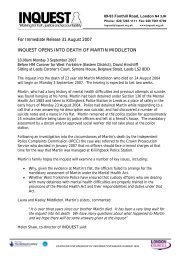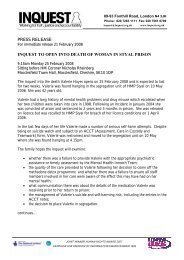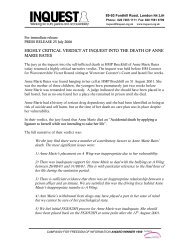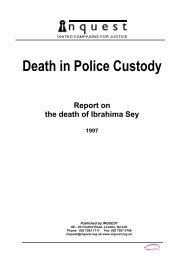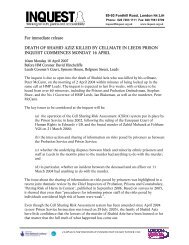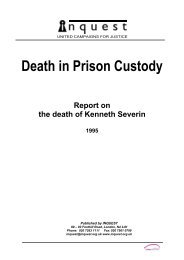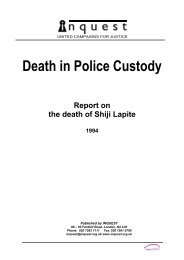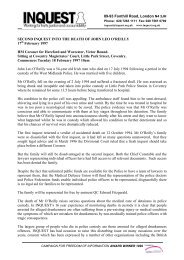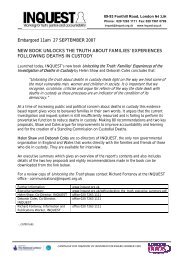Rocky Bennett Briefing - Inquest
Rocky Bennett Briefing - Inquest
Rocky Bennett Briefing - Inquest
Create successful ePaper yourself
Turn your PDF publications into a flip-book with our unique Google optimized e-Paper software.
Treatment and Responsibility<strong>Rocky</strong>’s sister, Dr Joanna <strong>Bennett</strong>, is herself a mental health professional and describes <strong>Rocky</strong>’streatment as having no focus [on his recovery] instead just treating him as though he wasdangerous and violent. She goes further to say that there is little or no evidence of anytherapeutic intervention to help <strong>Rocky</strong>’s progress in his will to manage his illness. She states thiswith some authority after spending many hours on the phone to his primary nurse in an effort toestablish what kind of care and treatment package her brother was being given. She was toldnothing apart from the fact that he was still symptomatic. This has implications in <strong>Rocky</strong>’s casebecause the only indication he had ever been given of his discharge was when he becamesymptom free. <strong>Rocky</strong> had been in the psychiatric system since 1980. He was very frustrated.The family feels that the patients and those in psychiatric care take a very much subordinateposition to the protection the institutions give themselves and their staff. Rather than theinstitution taking responsibility for <strong>Rocky</strong>’s death, his sister believes that those individual nursesresponsible for caring for <strong>Rocky</strong> should be held accountable. After that accountability is definedthen the professional bodies must be questioned about their training and policies that have leadto the death of one too many patients.Nurses involved in an incident such as that preceding the death of <strong>Rocky</strong> <strong>Bennett</strong> should not beable to continue to practise whilst an investigation is in progress. The NHS cannot continue totalk about good practice if as an institution it continues to defend nurses whose actions in suchcircumstance result in a death.Families’ motivation following a death is to find out the truth, including a full explanation fromofficial sources to prevent it happening again, to obtain an apology and an acknowledgement ofwrong doing or blameworthiness if found and for those responsible to be brought to account fortheir actions.Restraint of Black People – The IssuesSince the early 1990s INQUEST has monitored a disturbing pattern of deaths in custodyfollowing the excessive use of force by police officers. There have also been a number of deathsfollowing medical neglect. The disproportionate number of individuals, particularly Africans andAfrican-Caribbeans, dying in the aftermath of the use of force has reinforced the idea that manyof these deaths are a reflection of racism within institutions and that black people are amongstthose singled out for potentially lethal restraint. We call upon the governing bodies to create andenforce policies that will ensure the protection of those patients who are in psychiatric care toprove once and for all that racially motivated abuse such as this is not tacitly condoned at everylevel.Many of these cases have presented disturbing images of violence and racism – ascribing toblack people stereotypical characteristics of extraordinary strength and dangerousness,attempting to blame the victim for their own death either by their pathological condition or theirpersonal choice.Another group over represented are the mentally ill where ‘negative imagery’ once again informstheir treatment - the stereotype of the mentally ill as ‘mad’, ‘bad’ and ‘dangerous’.It would only serve to encourage public confidence if custodial institutions were seen to inviteand welcome public scrutiny of their actions in order that lessons are learnt and furthertragedies prevented.
For two decades we have documented our concerns about deaths where the use of restraint bystate agents has either caused or played a significant contributory factor in the death of thedeceased. Casework in police, prison and psychiatric custody has revealed concerns about theexcessive use of force generally, including the use of CS spray, US style batons, firearms, stripcells and medication as well as the use of dangerous 'control and restraint' methods such asbody belts, 'neck holds, and other restraint techniques resulting in the inhibition of therespiratory system, asphyxia and death.Cases have revealed a use of violence by state agents on some occasions that is greatlydisproportionate to the risks posed involving black people and the mentally ill. This raisesquestions about the attitudes and assumptions of some state officials and pre-conceived ideasabout the propensity to violence of particular groups of people.Mental Health Services for Black People – The IssuesAcademic research has shown that people from black and minority ethnic groups have greaterhealth problems and are less easily able to access health care than the dominant whitepopulation. 1Although these concerns have been widely documented and researched for several decades verylittle has been done. This has contributed to fear and distrust by people from minority ethnicgroups towards NHS mental health services. The key issues of over diagnosis; over use ofseclusion and detention; over use of medication and perhaps the most illustrative, the lack ofunderstanding of other cultures and the subsequent misunderstandings of patients are wellknown.Dr Joanna <strong>Bennett</strong> is concerned that direct and institutional racism is addressed within themental health system and that there is a commitment from government to ensure someone isaccountable for ensuring clear targets are set and action is taken.The Lack of Figures on Psychiatric DeathsOne of the most disturbing problems revealed by <strong>Rocky</strong>’s death is the lack of mandatory andcentral monitoring of the numbers of people who die in psychiatric custody and thecircumstances of their deaths. This contributes to a culture of secrecy and silence and thepossibility for cover up and inadequate public scrutiny of such deaths. INQUEST hascampaigned hard to get these figures from other custodial settings and as a result, we receivenotice of nearly all deaths that occur in prison and police custody. We are the only organisationin England and Wales who record these figures and keep track of the trends that occur invarious institutions. However there is no central database of figures of deaths in psychiatric careand therefore no figures of the deaths of people from minority ethnic groups in psychiatric care.Why can’t the health service achieve what the prison service and police now achieve withrelative ease?CommentAs the inquiry report on <strong>Rocky</strong> <strong>Bennett</strong> is released we note that there has been virtually nochange in practice within the NHS. There must be proper guidelines in place to ensure that saferestraint methods are used and that aggressive force is non existent. Standard centrallyaccredited training must be given to all those who could potentially use restraint within anycustodial setting to ensure minimal damage to human lives. We call for complete transparency1Inside Outside – Improving Mental Health Service for black and Minority Ethnic Communitiesin England 2003
within the mental health system in terms of its restraint policies, all deaths in psychiatric careand in particular those deaths that have been caused partially or fully by the use of restraint. Theinvestigation systems that follow such deaths must also be changed to ensure those responsibleare held to account at an individual and corporate level. We want the NHS to eliminate racismwithin its institution and to severely condemn any staff member who is found to bediscriminatory. Only then do we feel that the caring profession will be able to achieve what itsets out to do. Care and protect.The family in <strong>Rocky</strong> <strong>Bennett</strong>’s case were treated shoddily and with no respect. At no point couldthey confidently state what had happened to <strong>Rocky</strong> from the information given to them by theauthorities. At no time were they consulted on where <strong>Rocky</strong>’s body should be taken or about thepost-mortem. At no time were their decisions perceived as being more important than those ofthe institutions even though <strong>Rocky</strong> <strong>Bennett</strong> did not belong to an institution, he was part of the<strong>Bennett</strong> family.INQUEST 2004



